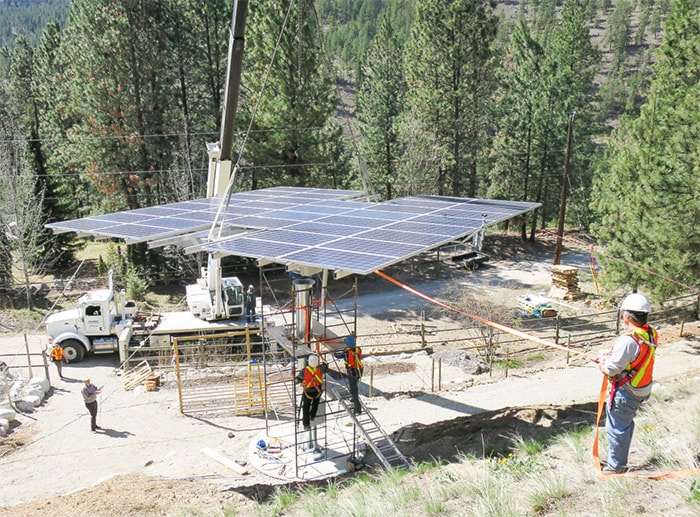In coming years, Jenny Paquet and Peter Lindelauf are going to be paying a lot less for electricity to power their West Bench home.
The couple decided to make the move to solar panels to generate electricity, but in a big way — They now have a 64 square metre solar panel array mounted on a six-metre mast on their rural property.
“It’s a bit of a risk, but I have thought about solar for 40 years,” said Paquet. “It seems like people just talk and talk about it and nobody ever does anything.”
The array, according to Susan Huber of Swiss Solar Tech/Pro Eco Energy, will generate 18,740 kilowatts of power annually, more than 70 per cent of the home’s requirement.
It also uses a GPS system to keep track of the sun’s position, adjusting the panels up and down and north to south for optimum positioning.
“This system is paid off faster because it is taking every little sun ray during the day it can get since it is moving with the sun,” said Huber. “When you want to get a tan, you always move towards the sun, right?”
That alone helps generate up to 55 per cent more energy annually than if the panels were in a fixed position, as on the roof of a home, which Paquet said was their first consideration.
She laughed, she said, when the Hubers suggested the large array on the mast, but became convinced when they showed her how their shaded roof was less than ideal, compared with the advantages of the tracked array.
The system should pay itself off in about 14 years, and provide free power thereafter. Meanwhile, there is also the possibility of selling power back to FortisBC on days when the array generates more power than Paquet and Lindelauf use.
“In the summer months, we will generate surplus electricity and Fortis’s net metering program allows us to run the meter backward and then we get a credit for every kilowatt/hour,” said Lindelauf, adding that there is another benefit.
“Apart from the financial side of things, what it gives us is a large degree of self sufficiency, when it comes to our power supply,” he said.
Paquet concurs, recalling a long-term power outage while she was growing up.
“When I lived in Portland Oregon, we had an ice storm and we lost power for a week. There was absolutely no heat; old people were dying in our neighbourhood,” she said, adding that with the new solar panels, they would be able to generate all the power they need in the daytime.
Paquet compares the cost of the installation to an luxury car.
“You could spend more for a nice car than you could for a solar (power) system,” she said.
“Do we want a new car with the leather interior, or do we want this?”
